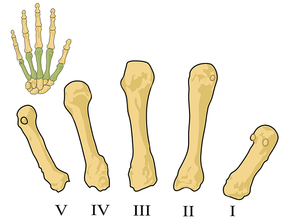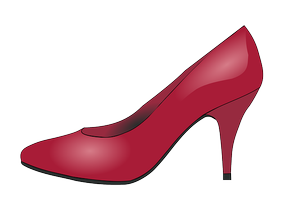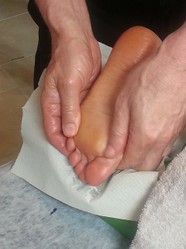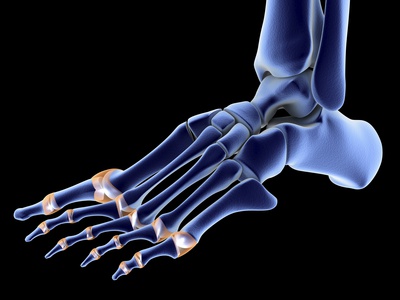Hallux valgus. It sounds like some sort of beautiful, exotic flower, doesn’t it? Nothing so charming. It is painful and ugly. It pushes your shoes out of shape. It is the common bunion. Although you wouldn’t call it common if you were on the receiving end of the pain it causes, you’d call it something far, far worse. Unfortunately, the treatments available are not necessarily as effective not as pleasing as we might like. Is surgery really the only answer?

The Dreaded Bunion
by Telesto
If you’ve ever suffered the pain of a bunion you’ll know why I called this “The Dreaded Bunion.” Pressure from shoes and the deformity puts on tendons and muscles causes pain.
What is a Bunion?
Including the "Science Bit."
A bunion, or Hallux valgus, is a deformity at the base of the big toe. More correctly, a bony deformity.
There are 26 bones in the human foot and 33 joints. The toes are known as the phalanges (we also have phalanges in our hands) and these are connected to the metatarsals. These poor little piggies do not have individual names; they are numbered from one to five, starting with the medial side (that's the middle side, the big toe).
A bunion occurs when the big toe (hallux, if you prefer) starts to point towards the other toes on the same foot. This forces the first metatarsal to stick out. This can lead to all sorts of problems, including swelling and pressure on the tendons and muscles in the foot.

The larger bones in this depiction are the phalanges. The smaller one also shows the metatarsals and where they join the cuneiform and cuboid bones. There are three cuneiform bones. This is an abridged, non-biological description, so don't expect to pass any anatomy exams on the basis of what I've written here!
What causes them and what can you do?
The experts don't agree on the cause. (Quelle surprise!) One of the theories is that there is a genetic component, and I'm here to tell you that I absolutely agree with that. My big toes have always faced the others, although I do have other deformities in my feet and probably should have worn my orthotic insoles more often. Ill fitting shoes don't help, although I have read that high heels retard the development of bunions. As someone who walked miles in 4-inch heels for the best part of her life, I agree with that. Despite what most people (me included, until I started researching this) think, bunions can occur in children. "Unusually flexible joints" are implicated, but I'll be honest, I haven't done a study on joint flexibility, but I don't think mine are unusually flexible. Or flexible at all anymore.
I went to my doctor, who told me my bunions were not bad enough to have surgery and that I should take painkillers, which I found wholly unsatisfactory. I asked my osteopath who suggested exercises (it is true that the offending toe can become less flexible, and even standing on tiptoe can become more difficult, so trying to keep it flexible is a must). She also suggested toe splints, which are "attractive" looking objects that you wear at night. Actually, I do find I get some relief from them.
Bunion pads are an option, but, to be honest, I just found that they made my shoes tighter and less comfortable. A friend swears by stretching her shoes with shoe stretchers a day or so before she wants to wear her high heels, but I now wear flats for any real walking, leaving my stilettos as "taxi shoes." I've had to say goodbye to a good many pairs, I'm sorry to say. Ice packs can, apparently, also help.
I tried something else too - in the US they are called "Bunion Booties," in the UK "Bunion Sleeves." They are not cheap - £24.95 or $33.95 (they do tend to do discounts for more than one) - but they do help a bit. I'll be honest, the first pair made the most difference, but I think the - cheaper - bunion splints help more.
Surgery?
Despite my doctor's insistence that surgery was not appropriate for me, the National Health Service is clear that surgery is the only way to correct a bunion. Charming. The NHS also makes it clear that, even after surgery, there still may be a limit to the kind of shoes you can wear. Ie, leave the sill stilettos behind. (Clearly most of the NHS doctors have never seen Zoe Hanna or Connie Beauchamp in BBC's Casualty, both of whom wear the MOST fantastic shoes. All day.) I digress.
So, what do they take into account?
Age, medical history, general health, lifestyle, occupation, your expectations of the surgery and the severity of the symptoms. So the usual then. All of these things are normally taken into account. Actually, they make sense.
Age - the medics don't like operating on bunions in children for fear that they will return. If you are very old, they might not think it's worthwhile, although I doubt that they will articulate that.
Medical History and General Health - some conditions make surgery more dangerous. The reality is that you will be pretty immobile for a while (see below) so if you already have a condition that is contra-indicated by poor circulation or poor healing, surgery may not be the best bet. If you are in one of these categories, discuss it with your doctors.
Lifestyle and occupation - the truth is, any surgery may have undesirable side effects. It may impact on the mobility of your foot/feet. If your job relies on your having full mobility, again, this may not be the right choice, although I rather wonder if pain versus mobility is much of a choice?
Expectations - now, this is what I really needed to know about. The usual rules of engagement apply: experience and skill of the surgeon, the type of surgery, how bad the bunions are when they undertake the surgery and how well you comply with the surgeons instructions afterwards.
The severity of the bunion - The current advice is that surgery is only an option if the pain is severe (how does anyone know that?) and the level of deformity.
Types of Surgery? Aftercare?
Are you sure you really want to read this? I'm not squeamish but reading about something you might have to have done can be a big off-putting, although, apparently, 85% of those who have surgery see an improvement.
Osteotomy - This is the most common type of bunion surgery and is usually just cutting the offending piece of bone and removing it. Then the surgeons have a bit of a fiddle and move things back into the right places. They may also do something to the soft tissue (muscles, etc) to put them back in the right places.
Arthrodesis - This is where two joints are fused together but it's really only used if there is sever deformity.
Excision (Keller's) anthroplasty - This is where the bunion and part of the bone at the base of the joint are removed. Thankfully, it's not commonly used.
Minimally Invasive Bunion Surgery - The NHS is a little tight-lipped, saying that "there is currently little reliable evidence of how effective or safe it is." But they would say that, wouldn't they?
It seems that in "normal" bunion surgery, there is a 5cm cut on the outside of the foot, whereas this surgery makes a cut of only 3mm. Quite a difference. It involves a bit of screwing and threading of wire through the toe.
Normal bunion surgery can mean being off your feet for three months minimum. (You can see now why your general health is important at the start. It's difficult, although not impossible, to exercise when you can only sit down with your feet elevated.) You may not be able to wear "proper" shoes for six months. The new surgery means that most people would be able to walk without crutches after six weeks, and full activity resumed after six months!
Me, I hate surgery and have just downloaded the book shown above, "The Hallux Valgus Cure" on the basis that it's cheaper than the Bunion Sleeve and may be a better option than surgery. I will update you in due course.
You might also like
Why Orthopedic Shoes Are the Best Choice for Your FeetIf the pain you are feeling is coming to a point where it is almost unbearabl...
Turning 50Today is my 50th birthday. This is a very big milestone birthday in my mind,...












 Identity Theft and How it Feelson 02/01/2015
Identity Theft and How it Feelson 02/01/2015
 Barts Hospital - a National Treasureon 01/24/2015
Barts Hospital - a National Treasureon 01/24/2015
 Urban Foxeson 01/11/2015
Urban Foxeson 01/11/2015
 How do you know which hosting platform to choose?on 01/03/2015
How do you know which hosting platform to choose?on 01/03/2015



Comments
I downloaded the book and have started doing the exercises. I'll let you know how it goes.
I agree with you about bunions being genetic. My grandfather and all of his siblings developed bunions with age.
Ouch, that sounds intensely painful. Ligaments tend to take a while to heal too. I hope you get something to help it soon.
Interesting article, I was looking for to braces just recently...but not for a bunion, my problem is on the top of my toe, a ligament I think that has been torn, the pain comes and goes, right now it's gone, so I'm doing okay, but when it comes now and then, it really hurts!!